The neuroanatomy of the siboglinid Riftia pachyptila highlights sedentarian annelid nervous system evolution
- PMID: 30543637
- PMCID: PMC6292602
- DOI: 10.1371/journal.pone.0198271
The neuroanatomy of the siboglinid Riftia pachyptila highlights sedentarian annelid nervous system evolution
Abstract
Tracing the evolution of the siboglinid group, peculiar group of marine gutless annelids, requires the detailed study of the fragmentarily explored central nervous system of vestimentiferans and other siboglinids. 3D reconstructions of the neuroanatomy of Riftia revealed that the "brain" of adult vestimentiferans is a fusion product of the supraesophageal and subesophageal ganglia. The supraesophageal ganglion-like area contains the following neural structures that are homologous to the annelid elements: the peripheral perikarya of the brain lobes, two main transverse commissures, mushroom-like structures, commissural cell cluster, and the circumesophageal connectives with two roots which give rise to the palp neurites. Three pairs of giant perikarya are located in the supraesophageal ganglion, giving rise to the paired giant axons. The circumesophageal connectives run to the VNC. The subesophageal ganglion-like area contains a tripartite ventral aggregation of perikarya (= the postoral ganglion of the VNC) interconnected by the subenteral commissure. The paired VNC is intraepidermal, not ganglionated over most of its length, associated with the ciliary field, and comprises the giant axons. The pairs of VNC and the giant axons fuse posteriorly. Within siboglinids, the vestimentiferans are distinguished by a large and considerably differentiated brain. This reflects the derived development of the tentacle crown. The tentacles of vestimentiferans are homologous to the annelid palps based on their innervation from the dorsal and ventral roots of the circumesophageal connectives. Neuroanatomy of the vestimentiferan brains is close to the brains of Cirratuliiformia and Spionida/Sabellida, which have several transverse commissures, specific position of the giant somata (if any), and palp nerve roots (if any). The palps and palp neurite roots originally developed in all main annelid clades (basally branching, errantian and sedentarian annelids), show the greatest diversity in their number in sedentarian species. Over the course of evolution of Sedentaria, the number of palps and their nerve roots either dramatically increased (as in vestimentiferan siboglinids) or were lost.
Conflict of interest statement
The authors have declared that no competing interests exist.
Figures


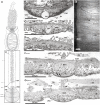


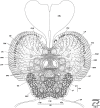

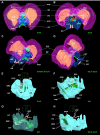
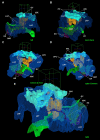
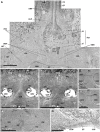


Similar articles
-
Neural reconstruction of bone-eating Osedax spp. (Annelida) and evolution of the siboglinid nervous system.BMC Evol Biol. 2016 Apr 14;16:83. doi: 10.1186/s12862-016-0639-7. BMC Evol Biol. 2016. PMID: 27080383 Free PMC article.
-
Owenia fusiformis - a basally branching annelid suitable for studying ancestral features of annelid neural development.BMC Evol Biol. 2016 Jun 16;16(1):129. doi: 10.1186/s12862-016-0690-4. BMC Evol Biol. 2016. PMID: 27306767 Free PMC article.
-
The anatomy and development of the nervous system in Magelonidae (Annelida) - insights into the evolution of the annelid brain.BMC Evol Biol. 2019 Aug 28;19(1):173. doi: 10.1186/s12862-019-1498-9. BMC Evol Biol. 2019. PMID: 31462293 Free PMC article.
-
Neuroanatomy of the vestimentiferan tubeworm Lamellibrachia satsuma provides insights into the evolution of the polychaete nervous system.PLoS One. 2013;8(1):e55151. doi: 10.1371/journal.pone.0055151. Epub 2013 Jan 23. PLoS One. 2013. PMID: 23372830 Free PMC article.
-
Is Diurodrilus an annelid?J Morphol. 2008 Dec;269(12):1426-55. doi: 10.1002/jmor.10686. J Morphol. 2008. PMID: 18985766 Review.
Cited by
-
Sensory cells and the organization of the peripheral nervous system of the siboglinid Oligobrachia haakonmosbiensis Smirnov, 2000.BMC Zool. 2022 Mar 29;7(1):16. doi: 10.1186/s40850-022-00114-z. BMC Zool. 2022. PMID: 37170298 Free PMC article.
-
Palps across the tree - the neuronal innervation and development of sensory head appendages in Annelida.Front Neurosci. 2024 Jan 4;17:1310225. doi: 10.3389/fnins.2023.1310225. eCollection 2023. Front Neurosci. 2024. PMID: 38239828 Free PMC article.
-
Neurons and Glia Cells in Marine Invertebrates: An Update.Front Neurosci. 2020 Feb 18;14:121. doi: 10.3389/fnins.2020.00121. eCollection 2020. Front Neurosci. 2020. PMID: 32132895 Free PMC article. Review.
-
May the palps be with you - new insights into the evolutionary origin of anterior appendages in Terebelliformia (Annelida).BMC Zool. 2021 Nov 16;6(1):30. doi: 10.1186/s40850-021-00094-6. BMC Zool. 2021. PMID: 37170288 Free PMC article.
References
-
- Schulze A, Halanych KM. Siboglinid evolution shaped by habitat preference and sulfide tolerance. Hydrobiologia. 2003;496: 199–205. 10.1023/A:1026192715095 - DOI
-
- Halanych KM. Molecular phylogeny of siboglinid annelids (a.k.a. pogonophorans): a review. Hydrobiologia. 2005;535–536: 297–307. 10.1007/s10750-004-1437-6 - DOI
-
- Karaseva NP, Rimskaya-Korsakova NN, Galkin SV, Malakhov VV. Taxonomy, geographical and bathymetric distribution of vestimentiferan tubeworms (Annelida, Siboglinidae). Biol Bull. 2016;43 10.1134/S1062359016090132 - DOI
-
- Webb M. Lamellibrachia barhami, Gen. Nov., Sp. Nov., (Pogonophora), from the Northeast Pacific. Bull Mar Sci. 1969;19: 18–47.
-
- Southward EC. Siboga-Expeditie Pogonophora. Siboga-Expeditie Uitkomsten op Zool Bonatisch, Oceanogr en Geol Geb verzameld Ned Oost-Indië 1899–1900. 1961;25: 1–22.
Publication types
MeSH terms
LinkOut - more resources
Full Text Sources

